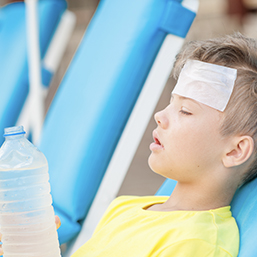
\n
Summer is a great time for families to be outdoors. However, too much heat can cause serious illness in people of all ages, both outdoor as well as indoor. The highest rates of death from heat-related illness are in the elderly, however infants and young children, as well as teenage athletes are also at significant risk. Being proactive to prevent heat illness and being aware of the signs and symptoms of it are important to ensure that outdoor summer activities are safe.
\n \nOur body temperature is kept within a healthy range by balancing heat gain from our body’s metabolism and our surroundings with heat loss, which happens when sweat evaporates from our skin. High humidity makes it a lot harder for our sweat to evaporate, so our dry prairie weather is somewhat protective against heat illness. We do get stretches of very hot weather in summer, though, so we remain at risk for heat illness.
\nThe risk of heat illness in children is higher than in adults because they have a higher rate of metabolism, they sweat less, and only start to sweat at a higher body temperature than adults. They are also less likely to drink enough fluids during activity unless they are reminded and encouraged by their caregivers. Infants, of course, require even more attention as they cannot drink on their own.
\nInfants and young children also cannot move themselves to a cooler environment like older children and adults can. This is particularly important with regard to car safety as the inside temperature of a car can rise dramatically on even just moderately hot days. Leaving a child unattended for even short periods of time in a hot car can result in disaster.
\nHeat exhaustion and heat stroke are the two most severe forms of heat illness, with heat stroke being the more serious and having the potential for death if not treated early and aggressively.
\nHeat exhaustion is diagnosed when a patient has been in the heat, has a higher-than-normal body temperature (37 to 40 degrees Celsius) and some or all of the following symptoms:
\nChildren who have these symptoms should stop their activity immediately and be taken into the shade or an air-conditioned vehicle or building. If appropriate, some clothing should be removed and the child given cold electrolyte liquids such as sports drinks. Most patients with mild heat exhaustion do not require further care as they will respond to these measures. If they do not, take them to an emergency or urgent care department for tests and treatment if needed.
\nHeat stroke happens if heat exhaustion is not treated. It is a medical emergency that can cause severe damage to the brain and internal organs, and needs to be treated quickly to avoid death. It is diagnosed when a patient has been in the heat, their temperature is over 40 degrees Celsius, and they have brain symptoms such as:
\nThey may also have rapid heart rate, headache, vomiting, diarrhea, muscle cramps, weakness and red skin. The skin can feel dry or very sweaty.
\nIf your child has heat stroke symptoms, call 911 immediately and start cooling them however you can, for example, with water or ice on their skin. Fanning can also help. Cooling measures will continue in the ambulance and in the emergency department. In the hospital, they will receive intravenous fluids and have tests to find out
\nif there has been any damage to organs in the body.
\nTo help prevent heat illness you can:
\nWith just a bit of preparation and awareness, we can ensure that our children always enjoy fantastic summer days without the fear of heat illness. Have a great summer!
\n\n
Dr. Cathryn Kuzyk has been a family physician for over four decades and is loving being grandma to five. She currently works part-time in family practice.
See our related articles:
\nCalgary’s Child Magazine © 2025 Calgary’s Child